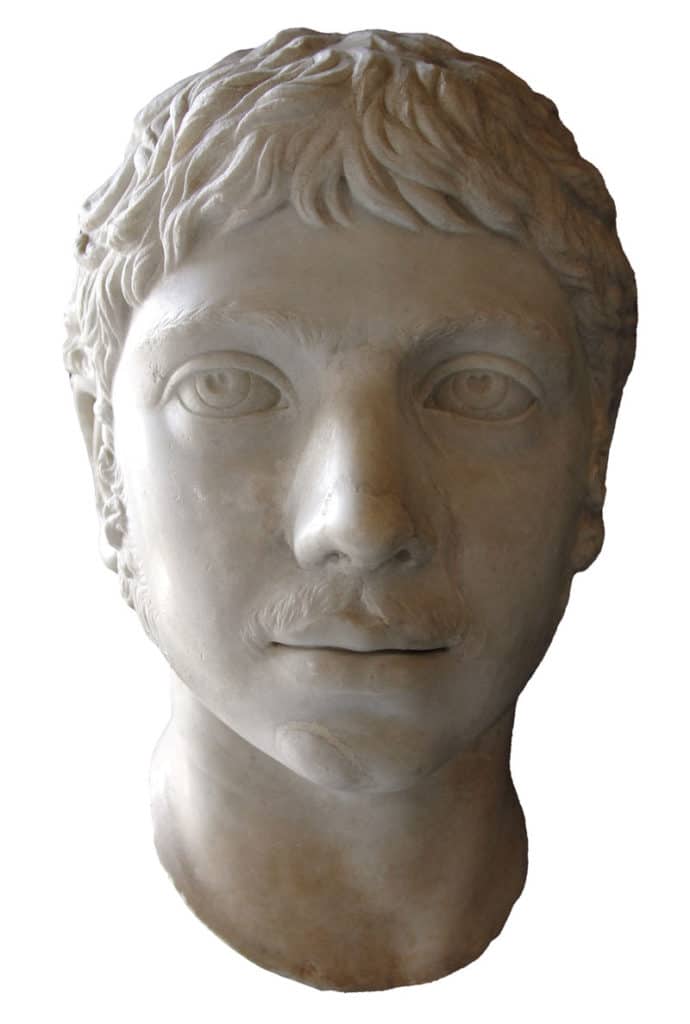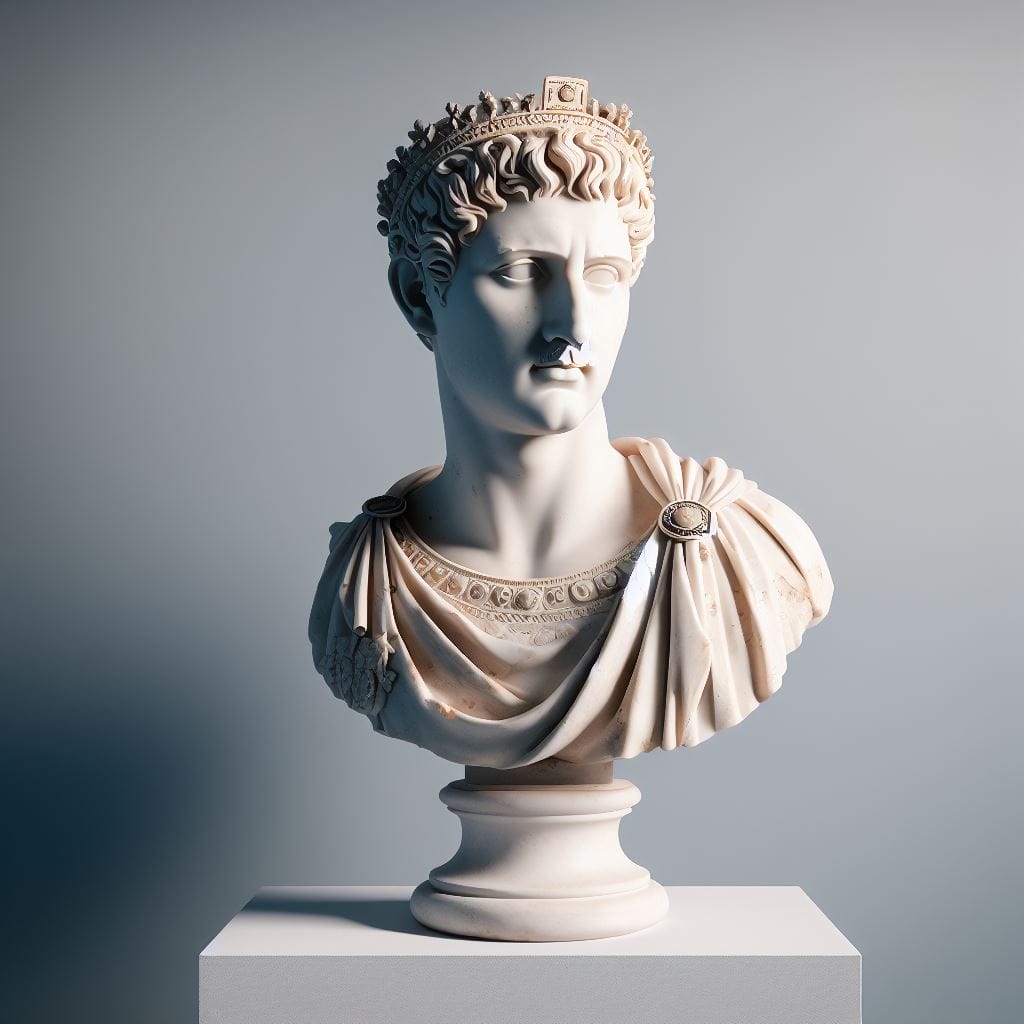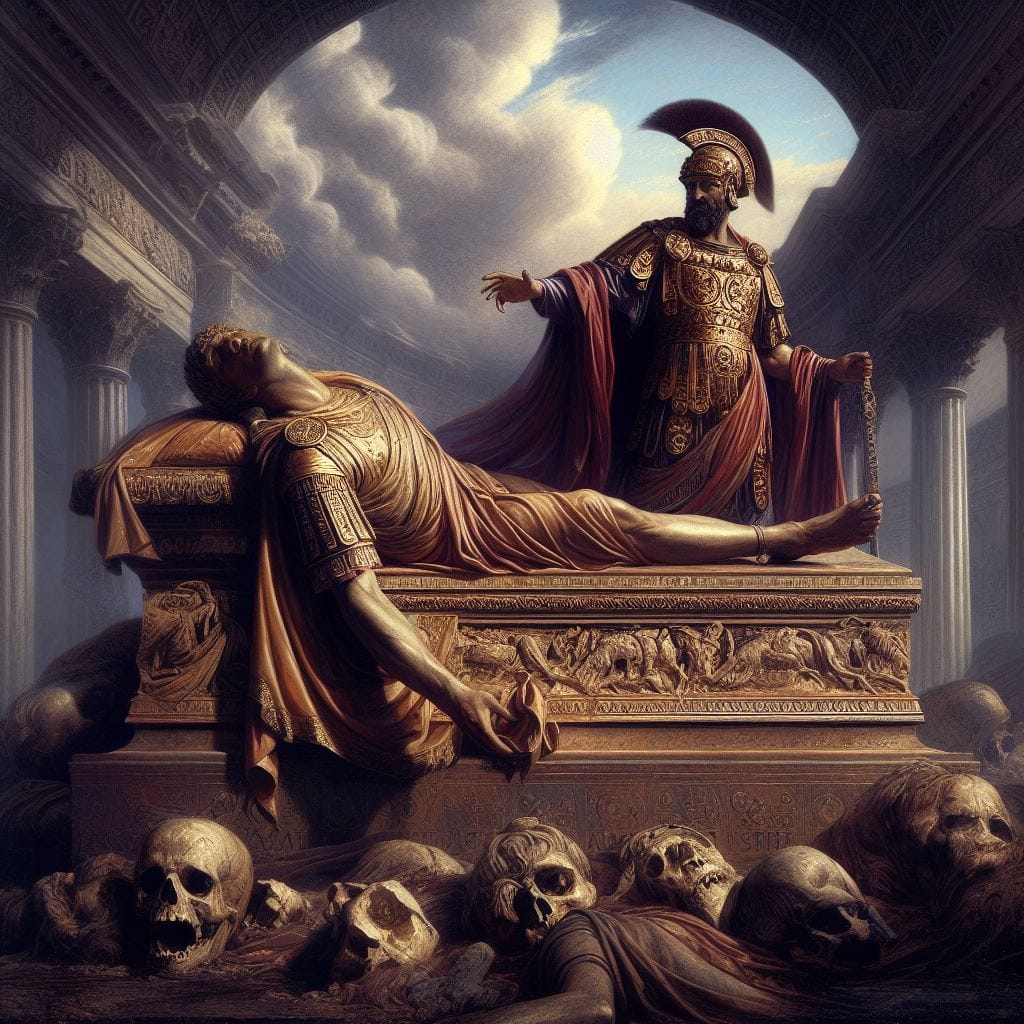Life: AD 204 – 222

- Name: Varius Avitus Bassianus
- Born AD 204 at Emesa in Syria.
- Consul AD 218, 219, 220, 222.
- Became emperor on 16 May AD 218.
- Wife: (1) Julia Cornelia, (2) Julia Aquilia Severa, (3) Annia Faustina.
- Died in Rome, on 11 March AD 222.
Early Life of Elagabalus
Elagabalus was born Varius Avitus Bassianus in AD 203 or 204 at Emesa in Syria. He was the son of the Syrian Sextus Varius Marcellus, who had become senator during the reign of Caracalla and Julia Soaemias, and it was his mother that Elagabalus should enjoy astounding connections. His maternal grandmother was Julia Maesa, widow to the consul Julius Avitus.
She was the younger sister of Julia Domna, widow of Septimius Severus and mother of Geta and Caracalla. Elagabalus held the hereditary rank of high priest to the Syrian sun god El-Gabal (or Baal).
The ascension to the throne by Elgabalus was entirely due to his grandmother’s will to see the downfall of Macrinus. Julia Maesa clearly held emperor Macrinus responsible for her sister’s death and now sought revenge. With Macrinus losing support with his peace deeply unpopular settlement with the Parthians, the time seemed great for an attempt to overthrow him. A rumor now was spread by Julia Soaemias herself that Elagabalus had actually been fathered by Caracalla.
If the memory of Caracalla was much cherished in the army, then support for his ‘son’ Elagabalus was now easily found. All along, a mysterious figure called Gannys seems to have masterminded the plot against Emperor Macrinus. He appears to have been either a eunuch servant of Julia Maesa or, in fact, the lover of Julia Soaemias.
Becoming an Emperor
Then, on the night of 15 May AD 218, the fateful moment arrived for Julia Maesa to let her plot unfold. Elagabalus, who was only fourteen years old, was secretly taken to the camp of the Legio III ‘Gallica’ at Raphaneae, and at the dawn of 16 May AD 218, he was presented to the troops by their commander Publius Valerius Comazon. Had the troops been bribed by a substantial sum paid for by the wealthy Julia Maesa, Elagabalus was hailed emperor and assumed the name Marcus Aurelius Antoninus. Nonetheless, he should become known as ‘Elagabalus’, the Romanized name of his god.
Remarkably, it was now Gannys who assumed command of the army which marched against Macrinus. As he advanced, his forces gathered strength, with more and more units of Macrinus changing sides. Finally, on 8 June AD 218, the two forces met outside Antioch. Gannys was victorious, Macrinus was executed shortly after, and Elagabalus was thereafter recognized as ruler throughout the empire. The senate responded by acknowledging him as emperor, confirming him the son of Caracalla, as well as deifying his ‘father’ Caracalla.
What is also noteworthy is that Elagabalus was not the only person to be elevated by the senate. His all-important grandmother Julia Maesa and his mother Julia Soaemias were each proclaimed Augusta – empress. There was no doubt with whom real power resided. It was definitely through these two women that the empire should be governed. Gannys now fell by the wayside. If, at first, there appeared to have been the intention of making Caesar marry Julia Soaemias, then he was executed at Nicomedia.
Already before the imperial entourage reached Rome, things began to sour. The very unit that had first bestowed imperial honors on Elagabalus revolted and instead proclaimed its new commander Verus emperor (AD 218). However, the revolt was quickly suppressed.

Becoming the most Influential Figure in the Government
The arrival of the new emperor and his two empresses at Rome in the autumn of AD 219 left the entire capital aghast. Among his imperial entourage, Elagabalus had brought with him many low-born Syrians, who were now granted positions in high office. Foremost among these Syrians was the very commander who had proclaimed Elagabalus emperor at Raphaneae, Publius Valerius Comazon. He was given the post of Praetorian prefect (and later city prefect of Rome) and became the most influential figure in government, aside from Julia Maesa.
But the greatest shock by far to the Romans came when they learned that Elagabalus had, in fact, brought the ‘Black Stone’ with him from Emesa. This stone was, in fact, the most holy object of the cult of the Syrian god El-Gabal and had always resided in its temple at Emesa. With it coming to Rome, it was made obvious to everyone that the new emperor intended to continue his duties as a priest of El-Gabal while residing in Rome. This was unimaginable. However, in spite of such public outrage, it did happen. A great temple was built on the Palatine hill, the so-called Elagaballium – better known as the ‘Temple of Elagabalus’, to hold the holy stone.
Having got off to such a bad start, the new emperor desperately needed to somehow improve his standing in the eyes of his Roman subjects. And so, already in AD 219, his grandmother organized a marriage between him and Julia Cornelia Paula, a lady of noble birth.
Any attempts to enhance Elagabalus’ standing with this marriage were, however, soon undone by the ardor with which he undertook the worship of his god, El-Gabal. Cattle and sheep were sacrificed in great numbers every day at dawn. High-ranking Romans, even senators, had to attend these rites. There are reports of severed human genitalia and small boys being sacrificed to the sun god, even though the truthfulness of these claims is very doubtful.
The Marriage of Gods
In AD 220, the emperor’s plans became known. He intended to make his god El-Gabal the first and foremost god (and master of all other gods!) of the Roman state cult. As if this was not enough, it was also decided that El-Gabal was to marry. In order to achieve a symbolic step, Elagabalus had the ancient statue of Minerva from the Temple of Vesta taken to the Elagaballium, where it was to be married to the Black Stone.
As part of this marriage of gods, Elagabalus also divorced his wife and married one of the Vestal Virgins, Julia Aquilia Severa (AD 220). Had in earlier days, sexual relations with a Vestal Virgin meant the immediate death penalty for both her and her lover, then this marriage of the emperor only further enraged public opinion.
Although the marriage between Elagabalus and Aquilia Severa went ahead, the emperor’s religious aspirations for El-Gabal had to be abandoned, for fear of the public’s reaction. Instead, the god El-Gabal, by now known to the Romans as Elagabalus – the same name used for their emperor – was ‘married’ to the less controversial moon goddess Urania.
If he had married the Vestal Severa in AD 220, he divorced her again in AD 221. In July of that year, he married Annia Faustina, who had among her ancestors no lesser than emperor Marcus Aurelius. More alarmingly, though, her husband had only been executed on Elagabalus’ orders a short while before the marriage. This marriage, although, was only to last a very brief time before Elagabalus abandoned it and instead declared he had never truly divorced Aquilia Severa and instead lived with her again. But this should apparently not be the end of Elagabalus’ marital adventures. According to one account, he had no less than five wives during his brief reign.
The Ellagabalium was not sufficient for the glory of El-Gabal – the emperor appears to have decided at some point. And so, a huge temple of the sun was built outside Rome, where the black stone was taken each year at midsummer in a triumphal procession. The emperor himself ran backward ahead of the chariot while holding the reigns of the six white horses which pulled it, thereby, fulfilling his duty never to turn his back on his god.

Elagabalus Shocking Private Life
Though Elagabalus should not only achieve notoriety with his religious fanaticism. He also shocked Roman society with his sexual practices. Were the Romans quite used to learning of their emperors – among them even the mighty Trajan – having a liking for young boys, then they had evidently never had an emperor such as Elagabalus. It appears most likely that Elagabalus was homosexual, for his interests lay clearly with men, and he seemed to have shown little desire for any of his wives. Further to this, Elagabalus seemed to bear the desire in him to be a woman. He had the hairs plucked from his body in order to appear more female and delighted in appearing in public wearing make-up.
He is said to have promised his physicians large sums of money if they would find a way to operate on him and turn him into a woman. More so, at court, a blond Carian slave named Hierocles acted as the emperor’s ‘husband’. Accounts also point to Elagabalus enjoying pretending to be a prostitute, offering himself naked to passers-by in the palace, or even prostituting himself in the taverns and brothels of Rome. Meanwhile, he would often arrange to be caught by Hierocles, who would then be expected to punish him for his behavior with a severe beating.
It was perhaps a little surprising that within the ranks of the army, Elagabalus did not carry undivided support. Had the revolt of the III ‘Gallica’ in Syria been an early warning, then since there had been revolts by the fourth legion, parts of the fleet, and a certain Seleucius?

Death
Such sexual antics, combined with his religious activities, made Elagabalus an ever more unbearable emperor for the Roman state. Julia Maesa alas decided that the young emperor and his mother Julia Soaemias, who increasingly encouraged his religious fervor, were truly out of control and would have to go. And so she turned to her younger daughter Julia Avita Mamaea, who had a thirteen-year-old son, Alexianus.
The two women managed to persuade Elagabalus to adopt Alexianus as Caesar, and heir. They explained that this would allow him to spend more time on his religious duties, while Alexianus would take care of other ceremonial obligations. And so Alexianus was adopted as Caesar under the name of Alexander Severus.
Soon afterward, however, in late AD 221, Elagabalus changed his mind and tried to have Alexander assassinated. Perhaps by then, he had realized what his grandmother intended.
In any case, Julia Maesa and Julia Mamaea managed to foil these attempts. Then they bribed the praetorian guards to rid the empire of its Syrian prince. On 11 March AD 222, when visiting the praetorian camp, the emperor and his mother Soaemias were set upon by the troops and killed. They were beheaded and their bodies were then dragged through the streets of Rome and, alas, thrown into the Tiber. A large number of Elagabalus’ henchmen subsequently also met with a violent death. He was 18 years old.
The black stone of the god El-Gabal was sent back to its true home in the city of Emesa.
People also ask:
What are some interesting facts about Elagabalus?
Elagabalus’ biographer tells us that the emperor procured men for political office based solely on the size of their penises.
Was Elagabalus Trans?
The question of whether the Roman Emperor Elagabalus (also known as Heliogabalus) was transgender is a complex and debated topic among historians. It’s important to understand this in the context of historical and cultural differences in gender identity and expression.
Elagabalus reigned from 218 to 222 AD and was known for his unconventional and controversial behavior, much of which was recorded by ancient historians who were often hostile towards him. Some of the behaviors attributed to him, such as wearing women’s clothing and cosmetics, and his reported desire for medical procedures to change his anatomy, have led some modern scholars to speculate that he might have identified more closely with what we today would understand as a female gender identity.
However, it’s crucial to approach this topic with caution. The understanding and concepts of gender in ancient Rome were vastly different from modern understandings of transgender identities. The historical sources about Elagabalus are also often biased, exaggerated, or based on hearsay, making it difficult to draw firm conclusions about his personal identity.
In summary, while some of Elagabalus’s reported behaviors might align with modern conceptions of transgender identity, it’s not possible to definitively categorize him as transgender by contemporary standards due to the vastly different cultural and historical contexts.
Why was Elagabalus unpopular?
The young emperor’s inexperience, controversial actions, and tumultuous personal life made him a target for discontented factions within the Roman Empire.
What did emperor Elagabalus do?
He forced leading members of Rome’s government to participate in religious rites celebrating this deity, presiding over them in person. He married four women, including a Vestal Virgin, in addition to lavishing favors on male courtiers thought to have been his lovers. He was also reported to have prostituted himself.
What toy did Elagabalus invent?
The whoopee cushion has reportedly been used since ancient times. Roman Emperor Elagabalus was said to enjoy practical jokes at his dinner parties and often placed whoopee cushions under the chairs of his more pompous guests.
What is the stone of Elagabalus?
Elagabal was personified by a conical black stone, which has been suggested to have been a piece of meteorite rock.

Historian Franco Cavazzi dedicated hundreds of hours of his life to creating this website, roman-empire.net as a trove of educational material on this fascinating period of history. His work has been cited in a number of textbooks on the Roman Empire and mentioned on numerous publications such as the New York Times, PBS, The Guardian, and many more.
